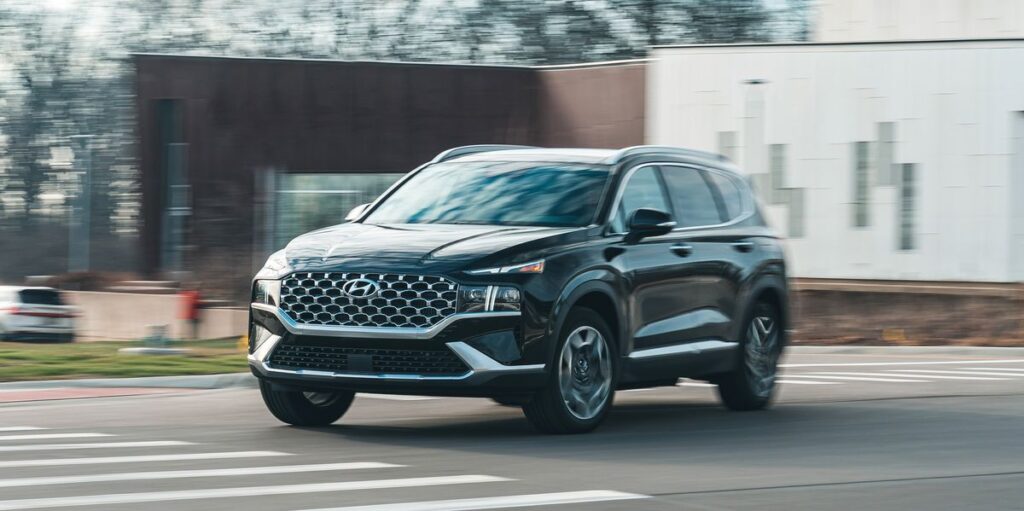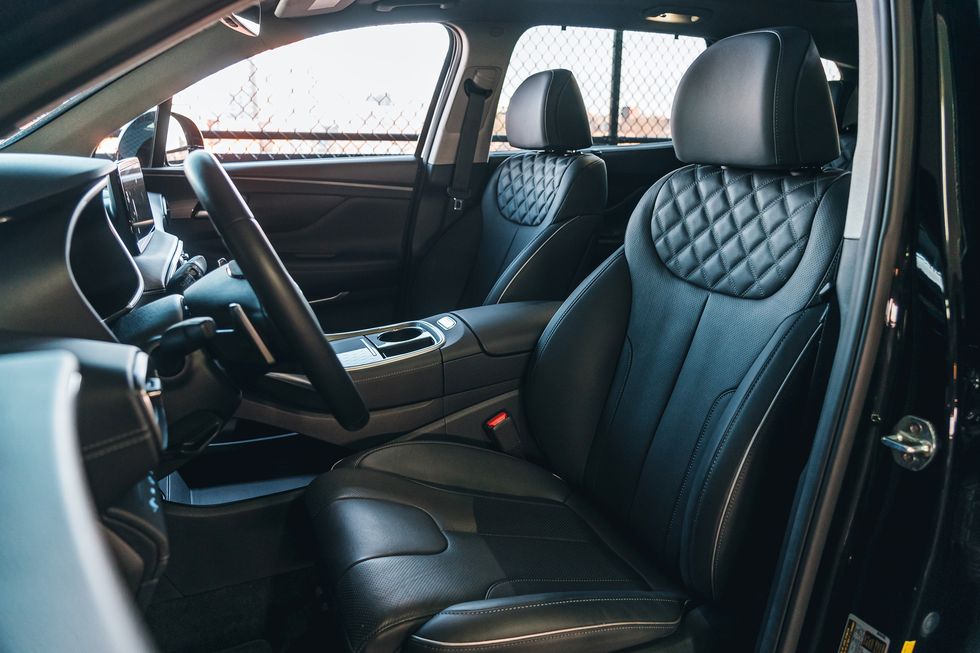2022 Hyundai Santa Fe PHEV Tested: Just Get the Regular Hybrid Instead

In theory, plug-in hybrids combine the best elements of both gas- and battery-powered vehicles. Capable of traveling far distances with reasonable efficiency courtesy of their gas engines and electric motors, PHEVs also can manage short romps of emission-free driving by way of their relatively large-capacity battery packs (for a hybrid) that can be recharged via an external power source.
By this logic, the Hyundai Santa Fe PHEV ought to make a prime candidate for today’s SUV-hungry consumers looking to enter the EV space without entirely abandoning the familiarity and reliable fueling infrastructure that comes with owning a gas-powered car. And yet this mid-size SUV, as both a gasoline-electric hybrid and an electric vehicle, manages to leave us wanting.
Marc Urbano|Car and Driver
Blame the fact that the plug-in’s powertrain provides no appreciable boost to fuel economy or performance over the regular Santa Fe hybrid and that the PHEV shares its core competencies with all other Santa Fe variants. So while it may be more complex, it’s not necessarily better than its more affordable hybrid counterpart.
More Motor
The PHEV is the latest addition to the Santa Fe’s powertrain lineup, which also includes a hybrid and two gas-powered four-cylinder options (one naturally aspirated, the other turbocharged), and it alters the basic Santa Fe formula by adding a lithium-ion battery pack with 12.4 kWh of usable capacity. According to the EPA, this affords a battery-electric driving range of 31 miles. In our 75-mph highway fuel-economy test, we managed 29 miles before draining the battery.
HIGHS: 31 miles of EV range, spacious interior, roomy cargo hold.
Netting those engine-off miles, however, requires a delicate right foot. Even a light prod of the accelerator fires up the 178-hp turbocharged 1.6-liter four-cylinder engine. The PHEV’s 90-hp electric motor—although brawnier than the hybrid Santa Fe’s 59-hp unit—struggles to move the 4505-pound SUV on its own.
Combined, the electric motor and the gas engine produce a total of 261 horsepower, enough to move the all-wheel-drive Santa Fe PHEV with acceptable aplomb. Accelerating to 60 mph requires 7.5 seconds, while the quarter-mile goes by after 15.7 seconds with a trap speed of 90 mph. Those figures mirror the Santa Fe hybrid’s results—the PHEV’s 261 pounds of additional mass compared to the hybrid largely negates its extra 35 horsepower. The PHEV did have a slight advantage in our passing-acceleration tests, though, beating the hybrid by 0.5 second from 30 to 50 mph and by 0.7 second from 50 to 70.
Mileage Matters
The PHEV is not appreciably quicker than the regular hybrid, nor is it more economical—at least not in our hands. While the EPA estimates that the Santa Fe PHEV will average 32 mpg on the highway, 2 to 3 mpg more than the regular Santa Fe hybrid, in our 75-mph highway-fuel economy test, the PHEV returned just 25 mpg versus the Santa Fe hybrid’s 31 mpg.

Marc Urbano|Car and Driver
The lack of a meaningful fuel-economy boost alone is arguably reason enough to bypass the Santa Fe PHEV in favor of the hybrid—then there is the aforementioned affordability factor. With a starting price of $47,305, a top-of-the-line 2022 Santa Fe PHEV Limited like our test example stickers for $5300 more than the equivalent Santa Fe hybrid, both with standard with all-wheel drive.
We also experienced some drivability issues with the PHEV. Toeing the accelerator off the line often resulted in a split second of . . . nothing . . . while the powertrain works through how it wants to dole out propulsion. Similarly, we had issues with the pedal response from the blended brakes. There can be a slight delay or nonlinearity to the brake pedal. For most drivers, it wouldn’t be a big deal, but in an emergency situation, some could find it alarming.
LOWS: Disappointing highway fuel economy, PHEV upcharge doesn’t pay off, undesirable input lag.
Also irksome is the fact Hyundai fails to offer any adjustments for the SUV’s regenerative-braking system. Whereas many of the automaker’s other battery-powered models allow the driver to adjust this by way of steering-wheel-mounted paddles, the plug-in Santa Fe’s paddles serve the sole purpose of manually controlling its six-speed automatic transmission, which can be slow to downshift when left on its own.
The PHEV is not without its positive attributes, but these are common to all Santa Fe models. The cabin benefits from ergonomic controls, myriad storage cubbies, and upgraded finishes this year. The five-seat SUV also offers comfortable seating and a versatile cargo hold—the latter swallowed 13 carry-on bags behind the rear seats in our testing and 27 with the seats folded. Passenger accommodations are generous, even though the PHEV suffers a minute reduction in rear-seat legroom due to the battery pack’s underfloor location.
Overall, the PHEV just doesn’t offer enough benefits over the regular Santa Fe hybrid, particularly given its extra cost. And Hyundai offers the Santa Fe PHEV only in California and the 10 other states (Colorado, Connecticut, Maine, Massachusetts, Maryland, New Jersey, New York, Oregon, Rhode Island, and Vermont) that have both adopted and enacted the California Air Resources Board’s zero-emissions-vehicle program. But car buyers who live elsewhere need not feel shortchanged. The cheaper, more efficient, and nationally available Santa Fe hybrid is the better choice anyway.
Specifications
Specifications
2022 Hyundai Santa Fe PHEV Limited
Vehicle Type: front-engine, front-motor, all-wheel-drive, 5-passenger, 4-door wagon
PRICE
Base/As Tested: $47,305 /$47,515
Options: carpeted floor mats, $210
POWERTRAIN
turbocharged and intercooled DOHC 16-valve inline-4, 178 hp, 195 lb-ft + AC motor, 90 hp, 224 lb-ft (combined output: 261 hp; 12.4-kWh lithium-ion battery pack; 3.6-kW onboard charger)
Transmission: 6-speed automatic
CHASSIS
Suspension, F/R: struts/multilink
Brakes, F/R: 12.8-in vented disc/12.0-in disc
Tires: Continental CrossContact LX Sport
235/55R-19 101H M+S
DIMENSIONS
Wheelbase: 108.9 in
Length: 188.4 in
Width: 74.8 in
Height: 66.3 in
Passenger Volume, F/R: 60/50 ft3
Cargo Volume, Behind F/R: 72/36 ft3
Curb Weight: 4505 lb
C/D TEST RESULTS
60 mph: 7.5 sec
1/4-Mile: 15.7 sec @ 90 mph
100 mph: 20.4 sec
120 mph: 35.0 sec
Results above omit 1-ft rollout of 0.4 sec.
Rolling Start, 5–60 mph: 7.5 sec
Top Gear, 30–50 mph: 3.8 sec
Top Gear, 50–70 mph: 4.7 sec
Top Speed (C/D est): 130 mph
Braking, 70–0 mph: 176 ft
Roadholding, 300-ft Skidpad: 0.83 g
C/D FUEL ECONOMY
Observed: 27 MPGe
75-mph Highway Driving, EV/Hybrid Mode: 76 MPGe/25 mpg
75-mph Highway Range, EV/Hybrid mode: 29/310 mi
EPA FUEL ECONOMY
Combined/City/Highway: 33/33/32 mpg
Combined Gasoline + Electricity: 76 MPGe
EV Range: 31 mi
C/D TESTING EXPLAINED



